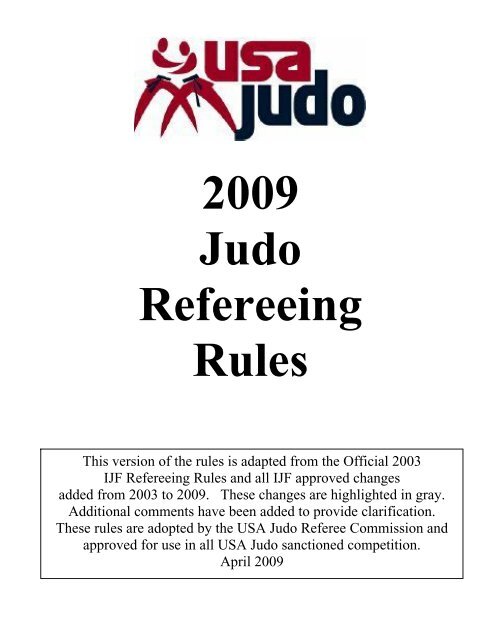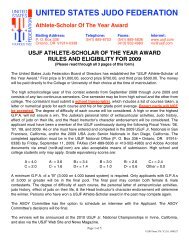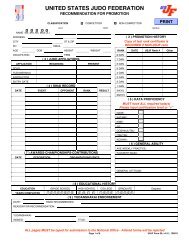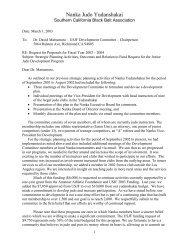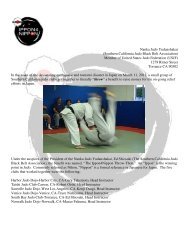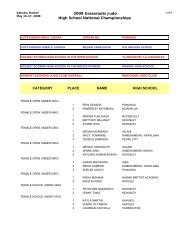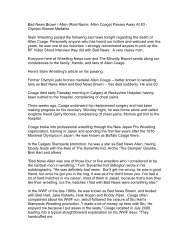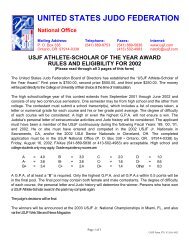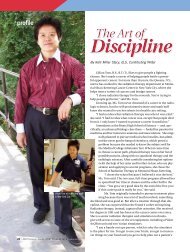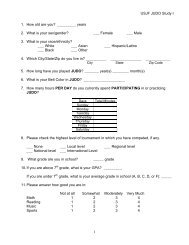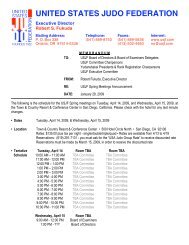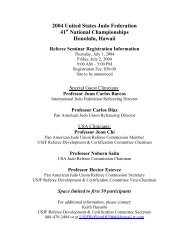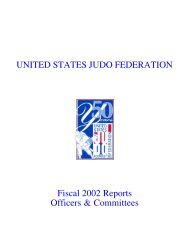2009 Judo Refereeing Rules - College Park Judo Club
2009 Judo Refereeing Rules - College Park Judo Club
2009 Judo Refereeing Rules - College Park Judo Club
You also want an ePaper? Increase the reach of your titles
YUMPU automatically turns print PDFs into web optimized ePapers that Google loves.
<strong>2009</strong><strong>Judo</strong><strong>Refereeing</strong><strong>Rules</strong>This version of the rules is adapted from the Official 2003IJF <strong>Refereeing</strong> <strong>Rules</strong> and all IJF approved changesadded from 2003 to <strong>2009</strong>. These changes are highlighted in gray.Additional comments have been added to provide clarification.These rules are adopted by the USA <strong>Judo</strong> Referee Commission andapproved for use in all USA <strong>Judo</strong> sanctioned competition.April <strong>2009</strong>
<strong>2009</strong> <strong>Judo</strong> <strong>Refereeing</strong> <strong>Rules</strong>ARTICLESPageArticle 1 • Competition Area 3Article 2 • Equipment 4Article 3 • <strong>Judo</strong> Uniform (<strong>Judo</strong>gi). 5Article 4 • Hygiene. 7Article 5 • Referees and Officials 7Article 6 • Position and Function of the Referee 8Article 7 • Position and Function of the Judges 8Article 8 • Gestures 9Article 9 • Location (Valid Areas) 12Article 10 • Duration of the Contest 12Article 11 • Time Out / Sono-mama / Mate 12Article 12 • Time Signal-Audible 12Article 13 • Osaekomi Time 13Article 14 • Technique Coinciding with the Time Signal 13Article 15 • Start of the Contest 13Article 16 • Entry into Ne-waza 14Article 17 • Application of Mate 14Article 18 • Sono-mama 15Article 19 • End of the Contest 16Article 20 • Ippon 18Article 21 • Waza-ari-awasete-Ippon 19Article 22 • Sogo-gachi 19Article 23 • Waza-ari 19Article 24 • Yuko 19Article 25 • Osaekomi-waza. 20Article 26 • Prohibited Acts and Penalties 20Article 27 • Default and Withdrawal 24Article 28 • Injury, Illness or Accident 24Article 29 • Situations not Covered by the <strong>Rules</strong> 262
<strong>2009</strong> JUDO REFEREEING RULESARTICLE 1 - Competition AreaThe competition area shall be a minimum of 14m x 14m (46’) to a maximum of 16m x 16m (52.5’) and shall becovered by Tatamis or similarly acceptable material.The competition area shall be divided into two (2) areas, the Contest Area and the Safety Area. The Contest Area isa minimum of 8m x 8m (26’) to a maximum of 10m x 10m (33’).The area outside the contest area shall be called the safety area and shall be 3m (9.84’) to 4m (13’) wide.The demarcation between the contest area and safety area shall be indicated by different colored tatami.A strip of blue and a strip of white adhesive tape, approximately 10cm (4”) wide and 50cm (20”) long shall beaffixed on the center of the contest area 4m (13’) apart, to indicate the starting positions at which the contestants muststart and end the contest.The blue tape shall be to the Referee's right and the white to his left.The competition area must be affixed to a resilient floor or platform (see Appendix).Where two (2) or more adjoining competition areas are used, a common safety area of between 3m and 4m isnecessary.A free zone, a minimum of 50cm (20”) must be maintained around the competition area.APPENDIX Article 1 - Competition AreaFor Olympic Games, World Championships, Continental and IJF events, the contest area, generally, must be 8m x8m.TatamiGenerally measuring 1m (3.28’) x 2m (6.5’), made of pressed straw or, more frequently, pressed foam.They must be firm under foot, have the property of absorbing shock during Ukemi, and not be slippery or too rough.The elements making up the surface for the competition must be aligned without space in between be smooth ofsurface and fixed in such a way that they cannot be displaced.PlatformThe platform is optional and must be solidly made of wood, while still having resilience and measuringapproximately 18m x 18m (56’) and no more 1m in height (generally 50cm (20”) or less).(When using a platform, it is recommended that the safety area should be 4 (13’)-5m(16.4’) wide all around thecompetition area).3
ARTICLE 2 – Equipmenta) Flags (Referee)A blue and a white flag for the Referee to use in the Hantei situation in the “Golden Score” contest shall be availableclose by the contest area (e.g. on the Technical Officials table or in a holster attached to the back judge’s chair.b) Chairs and Flags (Judges)Two (2) lightweight sturdy chairs must be placed on the safety area at diagonally opposite corners of the contest areaand in a position so as not to obstruct the Judges, Commission members and Scoreboard Keepers view of thescoreboard. A blue and a white flag shall be placed in a holster affixed to each chair.c) ScoreboardsFor each competition area there shall be two (2) scoreboards that indicate the scores horizontally, not exceeding90cm in height and 2m in width, placed outside the competition area where they can be easily seen by the Referees,Commission members, officials and spectators.Whenever electronic scoreboards are used, manual scoreboards must be available as a backup (see Appendix).d) Timing ClocksThere shall be timing clocks as follows:Contest Duration - One (1)Osaekomi- Two (2)In reserve - One (1)Whenever electronic timing clocks are used, manual timing clocks must also be used to check their accuracy (seeAppendix).e) Flags (Timekeepers)Timekeepers shall use flags as follows;Yellow -Time outGreen - Osaekomi durationIt will not be necessary to use the yellow and the green flags whenever an electronic display clock showing contestduration and Osaekomi duration is in use. However, these flags must be available in reserve.f) Time SignalThere shall be a bell or similar audible device to indicate to the Referee the end of the time allotted for the contest.g) Blue and White <strong>Judo</strong>gisThe contestant shall wear either a blue or white <strong>Judo</strong>gi. (The first Contestant called shall wear the blue <strong>Judo</strong>gi, thesecond shall wear the white.)APPENDIX Article 2 – EquipmentPosition of Scoreboard Keepers / Contest Sheet Writers / TimekeepersThe Contest Sheet Writers, Scoreboard Keepers and Timekeepers must be facing the Referee.Distance of SpectatorsIn general the spectators should not be permitted closer than 3m to the competition area (or platform).Timing Clocks and ScoreboardsThe timing clocks must be accessible to those persons responsible for maintaining their accuracy, and they must bechecked for accuracy at the start of and regularly during the competition. The scoreboards must meet the standardsset out by the IJF and should be at the disposal of the Referees as needed.The manual timing clocks must be used simultaneously with the electronic equipment, in case of failure of theelectronic timing clocks.4
The manual scoreboards must be available in reserve.c) Manual ScoreboardsWHITEBLUE0 1 0 0 1 1Ippon Waza-ariYuko5Ippon Waza-ariYukoShido 3 Shido 1 Shido 2 Shido 1EXAMPLE:Blue has scored Waza-ari and has also been penalized with three (3) Shidos.White has been penalized with two (2) Shidos.ARTICLE 3 - <strong>Judo</strong> Uniform (<strong>Judo</strong>gi)The contestants shall wear a <strong>Judo</strong>gi complying with the following conditions:a) Strongly made of cotton or similar material (see guidelines), in good condition (without rent or tear). The materialmust not be so thick or hard or slippery as to prevent the opponent from taking a grip.b) Blue for the first contestant and white or off-white for the second contestant. (See Appendix).c) Acceptable markings:1) National Olympic abbreviation (on back of jacket). Size of the letters 11 cm (4”).For IJF Events and the Olympic Games, the names are indicated on the 30 cm (11.8”) x 40 cm (15.7”)Bibs.2) National Emblem (on left breast of jacket). Maximum size 100cm 2 (16 in 2 ).3) Manufacturer's trade mark (on bottom-front of jacket, on bottom front of left leg of the trousers and on oneend of the belt). Maximum size 20 cm 2 (3 in 2 ). It is permitted to place the manufacturer's trade mark on oneof the sleeves but inside the 25cm (10”) x 5cm (2”) area instead of at the bottom front of the jacket. The IJFOfficial suppliers are allowed to place the IJF Logo above their trade mark (in direct contact).4) Shoulder markings (from collar - across shoulder down the arm – both sides of jacket). Maximum length25cm (10”) and maximum width 5cm (2”). (The same advertising or national colors on both sides).5) Advertising on the sleeves, 10 cm x 10 cm (4”x4”) on each sleeve (different advertising allowed). These100 cm² have to be fixed just below and in contact with the stripes of 25 cm (10”) x 5 cm (2”).6) Indication of the placing (1st, 2nd, 3rd) at the Olympic Games or World Championships, in an area of 6cm(2.4”) x 10cm (4”) at the bottom front left side of the jacket.7) The contestant's name may be worn on the belt, lower front of the jacket and upper front of the trousers upto a maximum of 3 cm (1.2”) x 10 cm (4”). Also the contestant's name or abbreviation may be placed(printed or embroidered), on the back of the jacket above the National Olympic abbreviation, but in no casein a position to prevent an opponent from grasping the back of the jacket. The letters can be up to amaximum of 7cm (2.8”) high and the length of the name can be up to a maximum of 30cm (12”) long. This7cm (2.8”) x 30cm (12”) rectangular area must be located 3cm (1.2”) below the collar of the jacket and theback identification must be fixed at 4cm (1.6”) below this area.
d) The jacket shall be long enough to cover the thighs and shall at a minimum reach to the fists when the arms arefully extended downwards at the sides of the body. The body of the jacket shall be worn with the left side crossedover the right and shall be wide enough to have a minimum overlap of 20cm (8”) at the level of the bottom of the ribcage.The sleeves of the jacket must reach to the wrist joint at the maximum and 5cm (2”) above the wrist joint at theminimum. A space of 10 (4”) to 15cm (6”) shall exist between the sleeve and the arm (bandages included), along theentire length of the sleeve. The lapel and collar must be a maximum of 1cm (0.4”) in thickness and 5cm (2”) inwidth.e) The trousers, free of any markings except for c3 and c7, shall be long enough to cover the legs and shall at themaximum reach the ankle joint and at the minimum 5cm (2”) above the ankle joint. A space of 10 cm (4”) to 15cm(6”) shall exist between the trouser leg and the leg (bandages included) along the entire length of the trouser leg.f) A strong belt, 4 (1.6”) to 5cm (2”) wide, whose color corresponds to the grade, shall be worn over the jacket goingtwice around it at waist, and tied with a square knot with the first loops inside the knot, tight enough to prevent thejacket from being too loose and long enough to leave 20 (8”) to 30cm (12”) protruding from each side of the knotwhen tied.g) Female contestants shall wear under the jacket either:1) a plain white or off-white T-shirt, with short sleeves, rather strong, long enough to be worn inside thetrousers, or 2) a plain white or off-white leotard with short sleeves.h) The official color standards for <strong>Judo</strong>gi blue are between Pantone numbers n°18-4051 and n°18-4039 on the TPPantone scale and between n°285 or n° 286 on the print Pantone scale.Note: For IJF Events and the Olympic Games, the name of the athlete is to be indicated on the back of the judogi..APPENDIX Article 3 - <strong>Judo</strong> Uniform (<strong>Judo</strong>gi)If the <strong>Judo</strong>gi of a contestant does not comply with this article, the Referee must consult with the judges (See Article26.34.The contestant’s spare <strong>Judo</strong>gi should be brought by the coach to his chair at the edge of the competition area.To ensure that the sleeves of the contestant's jacket are the required length, the Referee shall direct the contestant toraise both arms, fully extended forward at shoulder level, when making the control.The contestants must bring their judogi without any back identification to the sewing desk.6
ARTICLE 4 – Hygiene(a) The <strong>Judo</strong>gi shall be clean, generally dry and without unpleasant odor.(b) The nails of the feet and hands shall be cut short.(c) The personal hygiene of the contestant shall be of a high standard.(d) Long hair shall be tied so as to avoid causing inconvenience to the other contestant.APPENDIX Article 4 – HygieneAny contestant who will not comply with the requirements of Article 4 shall be refused the right to compete and theopponent shall win the contest by Fusen-gachi, if the contest has not yet started, or by Kiken-gachi, if the contest hasalready started, according to the "majority of three" rule (see Article 27).ARTICLE 5 - Referees and OfficialsGenerally, the contest shall be conducted by one Referee and two (2) Judges under the supervision of the <strong>Refereeing</strong>Commission.The Referee and Judges shall be assisted by Scoreboard Keepers and Timekeepers.The Referee’s uniform shall conform to the dress code of the Organization.APPENDIX Article 5 - Referees and OfficialsThe Timekeepers, Contest Sheet Writers and Scoreboard Keepers as well as other technical assistants must be aminimum of 21 years of age, have a minimum of three (3) years experience as national Referee and a goodknowledge of the <strong>Refereeing</strong> <strong>Rules</strong>.The Organizing Committee shall ensure that they have been thoroughly trained as technical officials. There shall be aminimum of two (2) Timekeepers; one to register the real contest time and one to specialize in Osaekomi time.If possible there should be a third person to supervise the two (2) Timekeepers to avoid any errors due to mistakes orforgetfulness.The overall Timekeeper (real contest time) shall start the clock on hearing the announcement of Hajime or Yoshi andshall stop it on hearing the announcement of Mate or Sono-mama.The Osaekomi Timekeeper shall start the clock on hearing Osaekomi, stop it on Sono-mama, and restart it on hearingYoshi. On hearing either Toketa or Mate he shall stop the clock and indicate the number of seconds elapsed to theReferee. On expiry of the time for Osaekomi (25 seconds or 20 seconds if the contestant applying the hold hasalready been awarded a Waza-ari or the contestant being held has been already penalized three (3) Shidos), he shallindicate the end of the Osaekomi by an audible signal.The Osaekomi Timekeeper shall raise a green flag whenever he starts the clock on hearing the announcement andseeing the signal of Osaekomi or Yoshi. He shall lower the flag when he stops the clock on hearing Toketa, Mate orSonomama, or on expiry of the time for Osaekomi.The overall Timekeeper (real contest time) shall raise a yellow flag whenever he stops the clock on hearing theannouncement and seeing the signal of Mate or Sono-mama and he shall lower the flag when he restarts the clock onhearing Hajime or Yoshi.When the time allowed for the contest has expired, the Timekeepers shall notify the Referee of this fact by a clearlyaudible signal (see Articles 10, 11 and 12 of the <strong>Refereeing</strong> <strong>Rules</strong>).7
The Scoreboard Keeper must ensure that he is thoroughly familiar with the current Referee gestures andannouncements, so that he can accurately indicate the progress and results of a contest.In addition to the above persons there shall be a Contest Sheet Writer to record the overall course of the contests.If electronic systems are used, the procedure shall be the same as described above. However manual timing clocksmust also be used simultaneously with the electronic equipment to ensure their accuracy and manual scoreboard mustbe available in reserve.ARTICLE 6 - Position and Function of RefereeThe Referee shall generally stay within the contest area. He shall conduct the contest and administer the decisions.He shall ensure that the decisions are correctly recorded.APPENDIX Article 6 - Position and Function of RefereeThe Referee should ensure that all is in good order e.g. competition area, equipment, uniforms, hygiene, technicalofficials etc. before starting the contest.While announcing an opinion and making the appropriate gesture, the Referee should bring at least one Judge withinhis line of sight in order to be immediately aware of any differing opinion. However the Referee must make sure notto lose sight of the contestants’ continuing action at any time.In cases when both contestants are in Ne-waza and facing outwards, the Referee may observe the action from thesafety area.Before officiating a contest, the Referees and Judges should familiarize themselves with the sound of the bell ormeans of indicating the end of the contest on their particular Tatami, and with the position of the doctor or medicalassistant.When assuming control of a competition area the Referee and Judges should ensure that the mat surface is clean andin good condition, that there are no gaps between the Tatamis, that the Judges chairs are in position and that thecontestants comply with Articles 3 and 4 of the <strong>Refereeing</strong> <strong>Rules</strong>.The Referees should ensure that there are no spectators, supporters or photographers in a position to cause a nuisanceor a risk of injury to the contestants.ARTICLE 7 - Position and Function of JudgesThe Judges must assist the Referee and sit opposite each other at two (2) corners outside the contest area.Each Judge must indicate his opinion by making the appropriate official gesture, whenever his opinion differs fromthat of the Referee on a technical evaluation or a penalty announced by the Referee.Should the Referee express an opinion on a technical result or a penalty of a higher degree than that of the two (2)Judges, he must adjust his evaluation to that of the Judge expressing the higher evaluation.Should the Referee express an opinion on a technical result or a penalty of a lower degree than that of the two (2)Judges, he must adjust his evaluation to that of the Judge expressing the lower evaluation.Should one Judge express an opinion of a higher degree and the other Judge an opinion of a lower degree than that ofthe Referee, the Referee must maintain his opinion.Should both Judges express a judgment different from that of the Referee, and the Referee does not notice theirsignals, they should stand up and maintain their gesture until the Referee is informed of this and rectifies hisevaluation. If after an appreciable time (a few seconds) the Referee has not noticed the standing Judges, the Judgewho is closest to the Referee must immediately approach him and inform him of the majority opinion.8
A Judge must, with the appropriate gesture, express his opinion about the validity of any action on the edge oroutside of the contest area.A discussion is possible and necessary only if the Referee or one of the Judges has clearly seen something which wasnot visible to the other two (2), and which could change their decision.The Judges must also ensure that the scores recorded by the Scoreboard Keepers are the scores announced by theReferee.Should a contestant need to temporarily leave the competition area after the contest has started for a reasonconsidered necessary by the Referee, a Judge must obligatorily go with the contestant to see that no anomaly occurs.This authorization shall be given only in exceptional circumstances (e.g. to change a <strong>Judo</strong>gi which does not conformto the rules).APPENDIX Article 7 - Position and Function of JudgesThe Referee and Judges should leave the competition area during presentations or any lengthy delay in the program.The Judges should sit with both feet apart, outside the contest area and place their hands, palms facing down, on theirthighs.Should a Judge notice that the scoreboard is incorrect he should draw the Referee's attention to the mistake.A Judge must be quick to remove himself and his chair should his position endanger the contestants.A Judge should not pre-empt the Referee's signal for a score.When an action occurs on the edge, the Judge should make the gesture immediately to show if the action is Jonai (In)or Jogai (Out).Should a contestant have to change any part of the <strong>Judo</strong>gi outside the competition area, and the Judge to accompanythe contestant is not of the same sex, an official designated by the <strong>Refereeing</strong> Director shall substitute for the Judgeand accompany the contestant.If his competition area is not in use and there is a contest in progress on an adjacent competition area, the Judgeshould remove his chair if it could endanger the contestants.ARTICLE 8 – Gesturesa) The RefereeThe Referee shall make gestures as indicated below when taking the following actions:1) Ippon: shall raise one arm with palm of hand facing forward, high above the head.2) Waza-ari: shall raise one of his arms with palm of hand facing downwards, sideways, to shoulder height.3) Waza-ari-awasete-ippon: First Waza-ari, then Ippon gesture.4) Yuko: shall raise one of his arms, with palm of hand facing downwards, 45 degrees from his body.5) Osaekomi: shall point his arms out from his body down towards the contestants while facing the contestants andbending his body towards them.6) Toketa: shall raise one of his arms to the front and wave it from right to left quickly two or three times whilebending his body towards the contestants.7) Hikiwake: shall raise one of his hands high in the air and bring it down to the front of his body (with thumb edgeup) and hold it there for a while.8) Mate: shall raise one of his hands to shoulder height with his arm approximately parallel to the Tatami and displaythe flattened palm of his hand (fingers up) to the Timekeeper.9) Sono-mama: shall bend forward and touch both contestants with the palms of his hands.10) Yoshi: shall firmly touch both contestants with the palms of his hands and bring pressure on them.9
11) To indicate the cancellation of an expressed opinion: shall maintain or repeat if lowered with one hand thesame gesture while raising the other hand above the head to the front and wave it from right to left two or three times.12) Hantei: In preparation of calling hantei, the Referee shall raise both hands forward at 45º with the correct flag ineach hand, and then at the announcement of hantei he shall raise the flag high above his head to indicate his opinion.13) To indicate the winner of a contest: shall raise one hand, palm in/up above shoulder height towards the winner.14) Not valid gesture: raise one arm (elbow straight) above his head and wave it from right to left two or threetimes to indicate that a throw outside is not valid or a throw after the sounding the end of the contest is not valid or inthe case of simultaneous techniques (so satsu) (See Article 20 Appendix).15) To direct the contestant(s) to re-adjust the <strong>Judo</strong>gi: shall cross left hand over right, palms facing inwards, atbelt height.16) To call the Doctor: shall face the medical table, wave an arm (palm upwards) from the direction of medicaltable towards the injured contestant.17) To award a penalty (Shido, Hansoku-make): shall point towards the contestant to be penalized with theforefinger extended from a closed fist.18) Non-combativity: shall rotate, with a forward motion, the forearms at chest height then point with the forefingerat the contestant to be penalized.19) False attack: shall extend both arms forward, with hands closed and then make a downward action with bothhands.b) The Judges1) Jonai: To indicate that he considers a contestant making a throwing technique has stayed within the contest area,the Judge shall raise one of his hands up in the air and bring it down to shoulder height with his thumb side edge ofthe hand upwards and arm extended along the boundary line of the contest area and hold it there for 3 to 5 seconds.2) Jogai: To indicate that in his opinion one of the contestants has gone out of the contest area, the Judge shall raiseone of his hands to shoulder height with his thumb side edge of the hand upwards and arm extended along theboundary line of the contest area and wave it from right to left, or vice-versa, several times.3) To indicate that in his opinion a score, penalty or opinion given by the Referee using anArticle 8 (a) gesture has no value, the Judge shall raise one arm (elbow straight) above his head and wave it fromright to left two or three times.4) To indicate that his opinion differs from that of the Referee, the Judge(s) shall make the appropriate Article 8 (a)gesture.5) In Hantei situations the Judges must hold the flags in the proper hands corresponding to the position of thecontestants. After the Referee has announced Hantei the Judges shall immediately raise either the blue or white flagabove their heads in order to indicate which contestant they consider merits the decision.6) When the Judges wish the Referee to announce Mate in Ne-waza (e.g. no progress), they shall signal this by risingboth hands to shoulder height with palms facing upwards.APPENDIX Article 8 – GesturesWhen it is not clearly apparent, the Referee may during the official signal, indicate with the other hand (palm flat,fingers together and palm up) to the blue or white tape (starting position) to indicate which contestant scored or waspenalized.To indicate to the contestant/s that he may sit cross-legged at the starting position if a lengthy delay in the contest isenvisaged, the Referee should signal towards the starting position with an open hand, palm upwards.Yuko and Waza-ari gestures should start with the arm across the chest, then sideways to the correct finishing position.Yuko, Waza-ari, Ippon, Osaekomi gestures should be maintained while moving to ensure that the score/call is clearlyvisible to the Judges. However, care should be taken when turning to keep the contestants within view.8) The Hikiwake gesture applies only to Team and Round Robin competitions.10
13) The Hantei situation described, will take effect only if there is a draw in scoring at the end of the time allotted forthe ‘Golden Score’ contest.Should both contestants be given a penalty, the Referee should make the proper gesture and point alternately at bothcontestants (left forefinger for contestant on his left and right forefinger for contestant on his right).Should a rectification gesture be required, it shall be done as quickly as possible after the cancellation gesture.There should be no announcement made when cancelling an expressed opinion.All gestures should be maintained for 3 to 5 seconds.To indicate the winner, the Referee shall return to his position at the start of the contest, take one step forward (leftfoot then right), indicate the winner and then take one step back (right foot then left).When a score or penalty should have been given, but the referee has not made a call or gesture, the judge(s) mayindicate the appropriate score with one arm while the other hand indicates (palm flat, fingers together, palm up) to theappropriate blue or white tape to identify who should receive the score. In the case of penalties the gestures shouldbe made followed by indicating which contestant should receive it. This should be repeated 2-3 times. This willalleviate any confusion.SHIDOHANSOKU-MAKE11
ARTICLE 9 - Location (Valid Areas)The contest shall be fought in the contest area and in dynamic action situations as described below.All actions are valid and may continue (no Mate) as long as either contestant has some part of his (or her) bodytouching the contest area. (Similar Ne-waza criterion is to be applied).Exceptions:a) After the original attack inside, award the appropriate score (if any) for any subsequent renraku-waza or kaeshiwazawhether one player is inside (contest area) or both are in the safety area (outside), as long as there is“continuity” and there is no clear break in the dynamic action.b) In Ne-waza the action is valid and may continue so long as either contestant has some part of his body touchingthe contest area.APPENDIX Article 9 - Location (Valid Areas)A competitor in “action” may play in the safety area as long as either contestant has some part of his/her bodytouching the contest area. Any break in or stall of the action warrants Mate.If the referee calls “Mate” in error and the judges believe the action and attack to be valid, they may nullify the Mateand score the throw. The Jury may be consulted. The officials must be sure that the call of Mate did not affect theuke’s defense.Any attack in the Dynamic Edge situation should have immediacy of result (reasonable completion time).In the case of Osaekomi on the edge if the one part of the contestant still touching the contest area becomes airborne(i.e. it is raised up and loses contact with the Tatami) the Referee must announce Mate.Once the contest has started, the contestants may only leave the competition area if given permission to do so by theReferee. Permission will only be given in very exceptional circumstances, such as the necessity to change a <strong>Judo</strong>giwhich does not comply with Article 3 or which because it has become damaged or soiled.ARTICLE 10 - Duration of the ContestFor the World Championships and Olympic Games, the time duration of contests is:Senior Men and Women: 5 minutes real contest timeJunior Men and Women: 4 minutes real contest timeAny contestant is entitled to a 10 minutes rest between contests.APPENDIX Article 10 - Duration of the ContestThe duration of the contests and the contest form shall be determined according to the rules of the tournament.The Referee should be aware of the duration of the contest before coming onto the competition area.ARTICLE 11 - Time OutThe time elapsed between the announcement of Mate and Hajime and between Sono-mama and Yoshi by the Refereeshall not count as part of the duration of the contest.ARTICLE 12 - Time SignalThe end of the time allotted for the contest shall be indicated to the Referee by the ringing of a bell or other similaraudible signal.12
APPENDIX Article 12 - Time signalWhen using several competition areas at the same time - the use of different audible signals is required.The time signal must be sufficiently loud to be heard over the noise of the spectators.ARTICLE 13 - Osaekomi TimeIppon: Total of 25 seconds.Waza-ari: 20 seconds or more but less than 25 seconds.Yuko: 15 seconds or more but less than 20 seconds.An Osaekomi of less than 15 seconds will be counted the same as an attack. Kinsa during Golden Score.APPENDIX Article 13 - Osaekomi TimeWhen Osaekomi is announced simultaneously with the time signal or when the remaining time is insufficient toallow for the completion of the Osaekomi, the time allotted for the contest shall be extended until either Ippon (orequivalence) is announced or the Referee announces Toketa or Mate.ARTICLE 14 - Technique coinciding with the Time signalAny immediate result of a technique started simultaneously with the time signal shall be valid.In the case of Osaekomi announced simultaneously with the time signal, the time allotted for the contest shall beextended until either Ippon (or equivalence) is scored or the Referee announces Toketa or Mate.APPENDIX Article 14 - Technique coinciding with the Time SignalAny technique applied after the ringing of the bell or other device to indicate expiration of the contest time shall notbe valid, even if the Referee has not yet announced Sore-made.Although a throwing technique may be applied simultaneously with the bell, if the Referee decides that it will not beeffective immediately, he shall announce Sore-made.ARTICLE 15 - Start of the ContestBefore the start of each contest the Referee and Judges shall stand together centered just inside the limits of thecompetition area and bow to Joseki before taking their places.Before leaving the competition area, they also must bow towards Joseki.Contestants must bow when stepping on and off the competition area at the start and end of the contest.The contestants shall then walk to the center of the edge of the contest area (on the safety area) at their respectiveside according the fighting order (first called on the right side and second called on the left side of the Referee’sposition), and remain standing there. At the signal from the Referee, the contestants shall move forward to theirrespective starting positions and bow simultaneously towards each other and take a step forward (left foot then right).Once the contest is over and the Referee has award the result, the contestants shall simultaneously take a step back(right foot then left) and bow to each other.The contestants are free to bow when entering or leaving the contest area, although it is not compulsory. (SeeBowing Guide).The contest shall always begin in the standing position.Only the members of the <strong>Refereeing</strong> Commission may interrupt the contest. (See Article 17)13
APPENDIX Article 15 - Start of the ContestThe Referee and Judges shall always be in position to start the contest before the arrival on the contest area of thecontestants. The Referee shall stand in the middle, 2m back from the line between where the contestants start. Heshall be facing the Timekeepers’ table.It is very important to perform the bow in a very correct way. When the contestants walk to their starting positionand are facing each other, they shall officially bow under the strict control of the Referee, repeating this procedure atthe end of the contest.If the contestants do not bow, the Referee shall direct the contestants to do so.All standing bows by the contestants shall be at an angle of 30 degrees measured at the waist.Bowing Procedure – see Bowing Guide.ARTICLE 16 - Entry into Ne-wazaContestants shall be able to change from the standing position to Ne-waza in the following cases but if the techniqueused is not continuous, the Referee shall order both contestants to resume the standing position:(a) When a contestant, after obtaining some result by a throwing technique changes without interruption into Newazaand takes the offensive.(b) When one of the contestants falls to the ground, following the unsuccessful application of a throwing techniquethe other may take advantage of his opponent's unbalanced position to take him to the ground.(c) When one contestant obtains some considerable effect by applying a Shime-waza or Kansetsu-waza in thestanding position and then changes without interruption to Ne-waza.(d) When one contestant takes his opponent down into Ne-waza by the particularly skillful application of amovement which does not qualify as a throwing technique.(e) In any other case where one contestant falls down or is about to fall down, not covered by the preceding subsectionsof this article, the other contestant may take advantage of his opponent's position to go into Ne-waza.APPENDIX Article 16 - Entry into Ne-wazaWhen one contestant pulls his opponent down into Ne-waza not in accordance with Article 16 and his opponent doesnot take advantage of this to continue into Ne-waza, the Referee shall announce Mate, stop the contest and penalizewith Shido the contestant who has infringed Article 26 (8). (See Article 26 Appendix, the 5th paragraph).When one contestant pulls his opponent down into Ne-waza not in accordance with Article 16 and his opponent takesadvantage of this to continue into Ne-waza, the contest shall be allowed to continue but the Referee shall penalizewith Shido the contestant who has infringed Article 26 (8). (See Article 26 Appendix, the 5th paragraph).ARTICLE 17 - Application of MateThe Referee shall announce Mate in order to stop the contest temporarily in the following cases; and to recommencethe contest, he shall announce Hajime:(a) When one or both of the contestants go outside the contest area. (See "Exceptions"- Article 9).(b) When one or both of the contestants perform one of the prohibited acts.(c) When one or both of the contestants are injured or taken ill.(d) When it is necessary for one or both of the contestants to adjust their <strong>Judo</strong>gi.(e) When during Ne-waza there is no apparent progress.14
(f) When one contestant regains a standing or semi-standing position from Ne-waza bearing his opponent on hisback.(g) When one contestant is in, or from Ne-waza regains, a standing position and lifts his opponent, who is lying onhis back with his leg(s) around any part of the standing contestant, clear of the Tatami.(h) When a contestant performs or attempts to perform Kansetsu-waza or Shime-waza from the standing position andthe result is not sufficiently apparent.(i) When in any other case that the Referee deems it necessary to do so.(j) When the Referee and Judges or <strong>Refereeing</strong> Commission wish to confer.APPENDIX Article 17 - Application of MateThe Referee having announced Mate, must take care to maintain the contestants within his view, in case they do nothear Mate announced and continue fighting.The Referee should not call Mate to stop the contestant(s) going outside the contest area, unless the situation isconsidered dangerous.The Referee should not announce Mate when a contestant, who has escaped e.g. from Osaekomi-waza, Shime-waza,Kansetsu-waza, appears in need of or calls for a rest.The Referee should announce Mate when a contestant who is face down on the Tatami, with his opponent clinging tohis back, succeeds in rising to a half standing position, with his hands clear of the Tatami, indicating a loss of controlby the opponent.Should the Referee call Mate in error during Ne-waza and the contestants therefore separate, the Referee and Judgesmay, if possible, and in accordance with the "majority of three" rule, replace the contestants into as close to theiroriginal position as possible and restart the contest, if so doing will rectify an injustice to one of the contestants.After the announcement of Mate, the contestants must quickly return to their starting positions.When the Referee has announced Mate, the contestant(s) must either stand if being spoken to or adjusting their<strong>Judo</strong>gis, or sit if a lengthy delay is envisaged. Only when receiving medical attention should a contestant bepermitted to adopt any other position.The Referee shall announce Mate in order to call for the doctor, either when the contestant or the doctor himself sorequests or when the Referee considers it is necessary. (See Article 28).ARTICLE 18 – Sono-mamaIn any case where the Referee wishes to temporarily stop the contest (e.g. to address one or both contestants withoutcausing a change in their positions, or to award a penalty so that the contestant who is not penalized does not lose hisposition of advantage), he shall announce Sono-mama. To recommence the contest, he shall announce Yoshi.Sono-mama can only be applied in Ne-waza.APPENDIX Article 18 – Sono-mamaWhenever the Referee announces Sono-mama, he must ensure that there is no change in the position or grip of eithercontestant.If during Ne-waza a contestant shows signs of injury, the Referee may separate the contestants if necessary afterannouncing Sono-mama and then return the contestants to the positions they held before the announcement of Sonomamaand then announce Yoshi.15
ARTICLE 19 - End of the ContestThe Referee shall announce Sore-made and end the contest:(a) When one contestant scores Ippon or Waza-ari-awasete-Ippon (Articles 20 and 21).(b) In the case of Sogo-gachi (Article 22).(c) In the case of Kiken-gachi (Article 27).(d) In the case of Hansoku-make (Article 26).(e) When one contestant cannot continue due to injury (Article 28).(f) When the time allotted for the contest has expired. The Referee shall award the contest as follows:1) Where one contestant has scored Ippon or equivalent, he shall be declared the winner.2) Where there has been no score of Ippon or equivalent, the winner shall be declared on the basis of: one Waza-ariprevails over any number of Yukos, one Yuko prevails over no recorded scores.3) Where there are no recorded scores or the scores are exactly the same under each point (Waza-ari, Yuko), thecontest shall be decided by the “Golden Score” contest.“Golden Score” ContestThe duration of the “Golden Score” contest shall be three (3) minutes.When the time allotted for the original contest ends, the Referee shall announce “Sore-made” to end the contesttemporarily and the contestants shall return to their starting positions. The scoreboard and time clocks shall be reset,then the Referee shall immediately announce “Hajime” to restart the contest in the normal way. There shall be no restperiod between the end of the original contest and the start of the “Golden Score” contest.The first score difference between the two (2) contestants during the “Golden Score” contest shall decide the contest.The contest ends as soon as a contestant gains any advantage.If the “Golden Score” contest goes the full duration without any advantage for either contestant, the result shall bedecided by Hantei.At the announcement of Hantei by the Referee, the Referee and the two (2) Judges shall raise the appropriate coloredflag high above their heads to indicate which contestant they consider to be the winner. In this case, the Referee andJudges shall only take into consideration “Kinsa” (slight superiority or inferiority) through the attitude, skill andeffectiveness of techniques during the “Golden Score” contest, that is to say, the original contest shall not count atall.The Referee shall declare the result according to the “majority of three” rule.Should only one contestant exercise his right to fight the “Golden Score” contest, and the other contestant declines,the contestant who wishes to fight shall be declared the winner by “Kiken-gachi”.4) In the case where both contestants score Ippon or Sogo-gachi simultaneously the contest shall be decided by the“Golden Score” contest.5) In the case where both contestants are penalized with accumulated Hansoku-make (result from successive Shidos)simultaneously, or where one contestant is penalized with an accumulated Hansoku-make and is simultaneouslyawarded Sogo-gachi, the contest shall be decided by the “Golden Score” contest.6) In the case where both contestants are penalized with direct Hansoku-make simultaneously, both contestants shallbe excluded from the tournament. (except in cases as described in Article 26-Appendix)7) The decision of “Hikiwake” shall be given, when there is no advantage on the scoreboard for either contestantwithin the time allotted for the contest. (See Appendix).16
After the Referee has indicated the result of the contest, the contestants shall take one step backwards (right foot thenleft) to their respective blue and white tapes, make a standing bow and leave the contest area.Once the Referee has indicated the result of the contest to the contestants, it will not be possible for the Referee tochange this decision after the Referee and Judges have left the competition area.Should the Referee award the contest to the wrong contestant in error, the two Judges must ensure that he changesthis erroneous decision before the Referee and Judges leave the competition area.All actions and decisions taken in accordance with the “majority of three” rule by the Referee and Judges shall befinal and without appeal.APPENDIX Article 19 - End of the ContestHaving announced “Sore-made”, the Referee shall always keep the contestants within his view, in case they do nothear his announcement and continue fighting.The Referee shall direct the contestants to adjust their <strong>Judo</strong>gis, if necessary, prior to indicating the result.Before each “Golden Score” contest, the timing clocks and scoreboards shall be fully reset as if for a new contest.During Golden Score, the first shido (free) may be given by the referee without consultation with the judges.The free shido should not be considered in the hantei decision in Golden Score unless it is absolutely the onlydifference between the two athletes.During Golden Score, the second shido may only be given after consultation with the judges. If 2 of the 3 officialsagree to award the penalty, then the penalty is awarded and the contest is ended. The referee and judges have theoption of consulting with the Jury.If the team is split 2-1 against, the referee and judges just do not give the penalty and the Golden Score contestcontinues. The referee and judges have the option of consulting with the Jury.In the “Golden Score” contest, when one contestant is being held and “Osaekomi” has been announced, the Refereeshall allow the hold down to continue for the 25 seconds (Ippon), until Toketa or Mate, or until Shime-waza orKansetsu-waza is applied by either contestant with immediate result. In this case, the contestant shall win by thepoints scored.During a Golden Score osaekomi, if tori commits a second shido at any time even 15-24 seconds into the osaekomi,the tori shall lose. The winner is determined by the first “called” score. There must be a majority of three opinion.If during the “Golden Score” contest a direct Hansoku-make is given, the result for the penalized player will incur thesame consequences as during a normal contest.7) The decision of “Hikiwake” will only be applied for Team competitions.During the first Team confrontation, the result of Hikiwake will be applicable.If, at the end of the confrontation, the number of victories and points is the same for both teams, then all the contestswith result of Hikiwake from the previous confrontation will be fought to decide the winning team. These decidingcontests shall be “Golden Score” contests; however, the victory will only be awarded one (1) point as a way ofdecision. (The same system shall be used in Round Robin competition).17
ARTICLE 20 - IpponThe Referee shall announce Ippon when in his opinion the applied technique corresponds to the following criteria:(a) When a contestant throws (starting from the standing position) or counters the other contestant with control,largely on his back with considerable force and speed. (four elements)(b) When a contestant holds with Osaekomi-waza the other contestant, who is unable to get away for 25 seconds afterthe announcement of Osaekomi.(c) When a contestant gives up by tapping twice or more with his hand or foot or says Maitta (I give up!) generally asa result of Osaekomi-waza, Shime-waza or Kansetsu-waza.(d) When a contestant is incapacitated by the effect of a Shime-waza or Kansetsu-waza.Equivalence: Should one contestant be penalized with Hansoku-make, the other contestant shall immediately bedeclared the winner.Simultaneous Ippons - See Article 19 (f) (4).APPENDIX Article 20 – IpponSimultaneous techniques: when both contestants fall to the Tatami after what appears to be simultaneous attacks, andthe Referee and Judges cannot decide which technique dominated there should be no score awarded.Should the Referee announce Ippon during Ne-waza in error and the contestants therefore separate, the Referee andJudges shall, if possible, and in accordance with the "majority of three" rule, replace the contestants into as close totheir original positions as possible and restart the contest, if so doing will rectify an injustice to one of thecontestants.If one of the contestants deliberately makes a "bridge" (head and one foot or both feet in contact with the tatami)after having been thrown - although he may have avoided the necessary criteria for Ippon, the Referee shallnonetheless award Ippon or any other score he considers the technique warrants, in order to discourage this action.Long landings (Continuity of Landing): Judgment on how a throw should score is based on the entire landing fromthe initial point of contact or impact to the final part of the body or back landing on the tatami when all controlledmovement ceases.The complete landing in nage-waza must be considered in total for scoring purposes, even if the action is slow,uneven (slight hesitation), or irregular (e.g. opposite side), so long as there is no clear break in the technique. Thelanding must be continuous.Using Kansetsu-waza in order to throw the opponent will not be considered for point scoring purposes.(d) NOTE: For Olympic Games, World Championships, Continental and IJF events, the rules shall be applied asstated. For National events, the organizers are authorized to make such provisions as are appropriate for the safety ofthe contestants at the level to which the tournament applies. For example, in lower grade competitions, the organizersmay authorize the Referees to award Ippon when the effect of a technique is sufficiently apparent, or for children'sevents, they may disallow Shime-waza and Kansetsu-waza altogether.18
ARTICLE 21 - Waza-ari-awasete-IpponShould one contestant gain a second Waza-ari in the contest, (see Article 23) the Referee shall announce Waza-ariawasete-ippon.ARTICLE 22 - Sogo-gachi (Compound Win)The Referee shall announce Sogo-gachi in the following cases:(a) Where one contestant has gained a Waza-ari and his opponent subsequently receives three (3) Shidos (see Article26 a).(b) Where one contestant, whose opponent has already received three (3) Shidos, is subsequently awarded a Wazaari.Simultaneous Sogo-gachi - See Article 19 (f) (4).ARTICLE 23 - Waza-ariThe Referee shall announce Waza-ari when in his opinion the applied technique corresponds to the followingcriteria:(a) When a contestant throws the other contestant (starting from the standing position) or counters, but thetechnique is partially lacking in one (1) of the four (4) elements necessary for Ippon (see Article 20 (a) andAppendix).(b) When a contestant holds with Osaekomi-waza the other contestant who is unable to get away for 20 seconds ormore, but less than 25 seconds.Equivalence: Should one contestant have been penalized three (3) Shidos, the other contestant shall receive Waza-ariimmediately.ARTICLE 24 – YukoThe Referee shall announce Yuko when in his opinion the applied technique corresponds to the following criteria:(a) When a contestant throws the other contestant (starting from the standing position or counters, but the techniqueis partially lacking in two (2) of the four (4) elements necessary for Ippon (see Article 20 (a) and Appendix).Examples:(1) Partially lacking in the element of "largely on the back" and is also partially lacking in one of the other three (3)elements of “control”, "speed" or "force".(2) Largely on the back but partially lacking in two (2) of the other three (3) elements of “control”, "speed" or"force".(b) When a contestant holds with Osaekomi-waza the other contestant who is unable to get away for 15 seconds ormore but less than 20 seconds.Equivalence: Should one contestant have been penalized two (2) Shidos, the other contestant shall receive Yukoimmediately.APPENDIX Article 24 – YukoRegardless of how many Yukos are announced, no amount will be considered equal to a Waza-ari. The total numberannounced will be recorded.19
Throwing an opponent on the front of his body, the front/side, knee(s), hand(s) or elbow(s) will only be counted thesame as any other attack. Similarly an Osaekomi of less than fifteen (15) seconds will be counted as an attack (Kinsain Golden Score).ARTICLE 25 - Osaekomi-wazaThe Referee shall announce Osaekomi when in his opinion the applied technique corresponds with the followingcriteria:(a) The contestant being held must be controlled by his opponent and must have his back, both shoulders or oneshoulder in contact with the Tatami.(b) The control can be made from the side, from the rear or from on top.(c) The contestant applying the hold must not have his leg(s) or body controlled by his opponent's legs.(d) At least one contestant must have some part of his body touching the contest area.(e) The contestant applying the hold must have his body in either the Kesa or the Shiho position, i.e. similar to thetechniques Kesa-gatame or Kami-shiho-gatame.APPENDIX Article 25 - Osaekomi-wazaShould a contestant who is controlling his opponent with an Osaekomi-waza, change without losing control, intoanother Osaekomi-waza, the Osaekomi time will continue until the announcement of Ippon (or equivalence), Toketaor Mate.When Osaekomi is being applied, if the contestant who is in an advantageous position commits an infringementmeriting a penalty, the Referee shall announce Mate, return the contestants to their starting positions, award thepenalty (and any score from the Osaekomi), then recommence the contest by announcing Hajime.When Osaekomi is being applied, if the contestant who is in a disadvantageous position commits an infringementmeriting a penalty, the Referee shall announce Sono-mama, award the penalty, then recommence the contest bytouching both contestants and announcing Yoshi. However, should the penalty to be awarded be Hansoku-make, theReferee shall, after announcing Sonomama, consult with Judges, announce Mate to return the contestants to theirstarting positions, then award Hansoku-make and end the contest by announcing Sore-made.If both Judges agree that an Osaekomi exists, but the Referee has not announced Osaekomi, they shall make theOsaekomi gesture and, by the "majority of three" rule, the Referee shall announce Osaekomi immediately.The Referee shall announce Mate in the case of "Osaekomi on the edge", when the one part of the contestant stilltouching the contest area, becomes airborne (i.e. it is raised up and loses contact with the Tatami).Toketa should be announced if, during Osaekomi, the contestant being held succeeds in "scissoring" the othercontestant's leg, either from above or from below the leg.In situations where the back of the contestant being held is no longer in contact with the Tatami, (e.g. "bridging"), butthe contestant applying the hold maintains control, the Osaekomi shall continue.ARTICLE 26- Prohibited Acts and PenaltiesThe Prohibited Acts are divided into ‘Slight’ infringements (Shido) and ‘Grave’ infringements (Hansoku-make).SLIGHT INFRINGEMENTS: Will receive a penalty of Shido.GRAVE INFRINGEMENTS: Will receive a penalty of direct Hansoku-make.The Referee shall award a penalty of Shido or Hansoku-make depending on the seriousness of the infringement.20
The first shido will be awarded and displayed on the scoreboard. However the opponent will NOT receive any score.The first shido will be free (a warning).The awarding of a second or subsequent Shido automatically reflects on the opponent’s technical score. The previousscore corresponding to the earlier penalty is removed and the next higher score shall be recorded immediately.The awarding of a direct Hansoku-make means the contestant is disqualified and excluded from the tournament, andthe contest ends according to the Article 19 (d). (See Appendix).Whenever a Referee awards a penalty, he should demonstrate with a simple gesture the reason for the penalty.A penalty can be awarded after the announcement of Sore-made for any prohibited act done during the time allottedfor the contest or, in some exceptional situations, for serious acts done after the signal to end the contest, as long asthe decision has not been given.SHIDO (Slight Infringements Group)(a) Shido is given to any contestant who has committed a slight infringement:1) To intentionally avoid taking Kumi-kata or prevent one’s opponent from taking hold in order to delay action inthe contest. (Generally more than 5 seconds)2) To adopt in a standing position, after Kumi-kata, an excessively defensive posture. (Generally more than 5seconds).3) To make an action designed to give the impression of an attack but which clearly shows that there was no intent tothrow the opponent. (False attack).4) In a standing position, to continually hold the opponent's sleeve end(s) for a defensive purpose (Generally morethan 5 seconds) or to grasp by "screwing up" the sleeve end(s).5) In a standing position, to continually keep the opponent's fingers of one or both hands interlocked, in order toprevent action in the contest. (Generally more than 5 seconds).6) To intentionally disarrange his own <strong>Judo</strong>gi or to untie or retie the belt or the trousers without the Referee'spermission.7) To pull the opponent down in order to start Ne-waza unless in accordance with Article 16.8) To insert a finger or fingers inside the opponent's sleeve or bottom of his trousers.9) In a standing position to take any grip other than a "normal" grip without attacking. (Generally more than 5seconds).10) In a standing position, before or after Kumi-kata has been established, not to make any attacking moves.(See Appendix Non-Combativity).11) To hold the opponent's sleeve end(s) between the thumb and the fingers (“Pistol” grip).12) To hold the opponent’s sleeve end(s) by folding it over (“Pocket” grip).13) From a standing position, to take hold of the opponent's foot/feet, leg(s) or trouser leg(s) with the hand(s), unlesssimultaneously attempting a throwing technique.14) To encircle the end of the belt or jacket around any part of the opponent's body.15) To take the <strong>Judo</strong>gi in the mouth. (either his own or his opponent’s <strong>Judo</strong>gi).16) To put a hand, arm, foot or leg directly on the opponent's face.17) To put a foot or a leg in the opponent's belt, collar or lapel.18) To apply Shime-waza using the bottom of the jacket or belt, or using only the fingers.19) To go outside the contest area or intentionally force the opponent to go outside the contest area either in standingposition or in Ne-waza. (See Article 9 - "Exceptions").20) To apply leg scissors to the opponent's trunk (Dojime), neck or head. (Scissor with crossed feet, while stretchingout the legs).21) To kick with the knee or foot, the hand or arm of the opponent, in order to make him release his grip, or to kickthe opponent’s leg or ankle without applying any technique.22) To bend back the opponent's finger(s) in order to break his grip.21
HANSOKU-MAKE (Grave Infringements Group)(b) Hansoku-make is given to any contestant who has committed a Grave Infringement (or who having been giventhree (3) Shidos, commits a further Slight Infringement):23) To apply Kawazu-gake. (To throw the opponent by winding one leg around the opponent's leg, while facingmore or less in the same direction as the opponent and falling backwards onto him).24) To apply Kansetsu-waza anywhere other than to the elbow joint.25) To lift off the Tatami the opponent who is lying on the Tatami and to drive him back onto the Tatami.26) To reap the opponents supporting leg from the inside when the opponent is applying a technique such as Haraigoshietc.27) To disregard the Referee's instructions.28) To make unnecessary calls, remarks or gestures derogatory to the opponent or Referee during the contest.29) To make any action which may endanger or injure the opponent especially the opponent's neck or spinalvertebrae, or may be against the spirit of <strong>Judo</strong>.30) To fall directly to the Tatami while applying or attempting to apply techniques such as Ude-hishigi-wakigatame.31) To "dive" head first, onto the Tatami by bending forward and downward while performing or attempting toperform techniques such as Uchimata, Harai-goshi, etc. or to fall directly backwards while performing orattempting to perform techniques such as Kata-guruma whether standing or kneeling.32) To intentionally fall backwards when the other contestant is clinging to his back and when either contestant hascontrol of the other's movement.33) To wear a hard or metallic object (covered or not).34) To come onto the competition area with an illegal judogi.On the scoreboard, the repeated Shido will be accumulated and converted to the opponent’s technical score: On thescoreboard repeated Shidos, would become:2 Shidos = a Yuko to the opponent3 Shidos = a Waza-ari to the opponent4 Shidos = Hansoku-make = Ippon to the opponentWhen a contestant has repeated slight infringements and is to be penalized with his fourth (4th) Shido the Referee,after consultation with Judges, shall give the contestant “Hansoku-make”, that is to say that the 4th Shido is notannounced as “Shido”, but shall be announced directly as “Hansoku-make”. The contest ends according to the Article19 (d).APPENDIX Article 26- Prohibited Acts and PenaltiesReferees and Judges are authorized to award penalties according to the "intent" or situation and in the best interest ofthe sport.The application of any negative judo penalties, such as refusal to grip should be made with logical (intuitive) timingand should be made in conjunction with the dynamic (spirit) of the contest.Should the Referee decide to penalize the contestant(s), (except in the case of Sono-mama in Ne-waza) he shalltemporarily stop the contest by announcing Mate, return the contestants to their starting positions and announce thepenalty while pointing to the contestant(s) who committed the prohibited act.There are occasions in ne-waza when it may be necessary to penalize a contestant on the fly (run) because to callSonomama would disturb the dynamic flow of the action which could affect the advantage of either of thecontestants.Before awarding Hansoku-make, the Referee must consult with the Judges and make his decision in accordance withthe "majority of three" rule.22
Where both contestants infringe the rules at the same time, each should be awarded a penalty according to theseriousness of the infringement.Where both contestants have been given three (3) Shidos and subsequently each receives a further penalty, theyshould both be declared Hansoku-make.A penalty in Ne-waza should be applied in the same manner as in Osaekomi (Article 26 Appendix, the 2nd and 3rdparagraphs).1) Avoid taking hold: This includes blocking to prevent kumi-kata.This also now includes crushing. That is keeping the opponent in a bent-over posture using an over-the-back“crushing” grip to prevent kumi-kata. (Generally more then 5 seconds).3) The referee will be more vigilant in the enforcement of false attacks including diving at the legs without a clearattempt at a throw, drop seoi-nage without a clear attempt at a throw or similar false attacks. These are mitigated ofcourse by the opponent’s obvious defense. A true failed attack is not a false attack.7) Where one contestant pulls his opponent down (Hikkomi) into Ne-waza not in accordance with Article 16 and hisopponent does not take advantage of this to continue into Ne-waza, the Referee shall announce Mate, temporarilystopping the contest and give Shido to the contestant who has infringed Article 16.The use of Tomoe-nage to enter into Juji-gatame or similar techniques (such as Hikkomi gaeshi) are acceptable aslong as the attack is continuous and skillful.9) “Normal” Kumi-kata is taking hold the right side of the opponent’s <strong>Judo</strong>gi, be it the sleeve, collar, chest area, topof the shoulder or back with the left hand and with the right hand the left side of the opponent’s <strong>Judo</strong>gi be it thesleeve, collar, chest area, top of the shoulder or back and always above the belt.If a contestant continues to take an abnormal Kumi-kata, the time allowed may be progressively reduced, and even toa “direct penalty” of Shido.A contestant should not be penalized for holding with an abnormal grip if the situation has been brought about by hisopponent ducking his head beneath the holder's arm. However, if a contestant is continually "ducking" this way, theReferee should give consideration as to whether he is adopting an "excessively defensive posture" (2).Hooking one leg between the opponent’s legs unless simultaneously attempting a throwing technique is notconsidered to be the normal Kumi-kata and the contestant must attack within 5 seconds or the contestant will bepenalized with “Shido”.10) “Non-combativity” may be taken to exist when in general, for approximately 25 seconds; there have been noattacking actions on the part of one or both contestants.Non-combativity should not be awarded when there are no attacking actions, if the Referee considers that thecontestant is genuinely looking for the opportunity to attack.13) A player may NOT "first" grab the trouser leg(s) then attack, but may grab the trousers to assist in finishing anattack that has already been initiated. Grabbing the trousers first, results in an immediate Mate and (shido).Grabbing the pants in the midst of an ongoing attack or simultaneously in order to finish the attack should not bestopped or penalized.Grabbing (Grasping) the leg (not pants) – (as in Morote-gari and Kibisu-gaeshi) without grabbing the trousers/pantsis still legal. These actions should not be stopped or penalized and any subsequent action should be scored.23
14) The act of "encircling" means that the belt or jacket must completely encircle. Using the belt or jacket as an"anchor" for a grip (without encircling), e.g. to trap the opponent's arm, should not be penalized.16) The face means the area within the line bordered by the forehead, the front of the ears and the jaw-line.23) Even if the thrower twists/turns during the throwing action, this should still be considered “Kawazu-gake” and bepenalized.Techniques such as O-soto-gari, O-uchi-gari, and Uchi-mata where the foot/leg is entwined with opponent’s leg willbe permitted and should be scored.30) To attempt such throws as Harai-goshi, Uchi-mata, etc., with only one hand gripping the opponent's lapel from aposition resembling Ude-hishigi-waki-gatame (in which the wrist of the opponent is trapped beneath the thrower'sarmpit) and deliberately falling, face down, onto the Tatami is likely to cause injury and will be penalized. No intentto throw an opponent cleanly onto his back is a dangerous action and will be treated in the same way as Ude-hishigiwaki-gatame.31) Diving - The offender is only out of the contest, not from any subsequent contests.34) Illegal <strong>Judo</strong>gi – All three officials must be in agreement. If the vote is 2-1 for, then the Jury must be consulted.If the vote is 2-1 against, then the contest is continued. The Sokuteiki (judogi measuring device) or other measuringdevice must be used. The offender is only out of that contest, not from any subsequent contests.ARTICLE 27- Default and WithdrawalThe decision of Fusen-gachi shall be given to any contestant whose opponent does not appear for his contest. Acontestant, who is not at his starting position after three (3) calls at one (1) minute intervals, will forfeit the contest.The Referee must be sure before awarding Fusen-gachi that he has received the authority to do so by the <strong>Refereeing</strong>Commission.The decision of Kiken-gachi shall be given to any contestant whose opponent withdraws from the competition forany reason, during the contest.APPENDIX Article 27- Default and WithdrawalSoft contact lens: - In the event that a contestant loses his contact lens during the contest and cannot immediatelyrecover them, and if he then informs the Referee that he cannot continue competing without the contact lens, theReferee shall give the victory to his opponent by Kiken-gachi after consulting with the Judges.ARTICLE 28- Injury, Illness or AccidentThe decision of the contest where one contestant is unable to continue because of injury, illness or accident duringthe contest shall be given by the Referee after consultation with the Judges according to the following clauses:a) Injury(1) Where the cause of the injury is attributed to the injured contestant he shall lose the contest.(2) Where the cause of the injury is attributed to the uninjured contestant the uninjured contestant shall lose thecontest.(3) Where it is impossible to determine which of the contestants was the cause of the injury, the contestant unable tocontinue shall lose the contest.b) SicknessGenerally, where one contestant is taken sick during a contest and is unable to continue, he shall lose the contest.24
c) AccidentWhere an accident occurs which is due to an outside influence (force majeure), after consulting with the RefereeCommission, the contest shall be considered cancelled or postponed. In those cases of ‘force majeure’, the SportsDirector, the Sports Commission and/or the IJF Jury will take the final decision.Medical Examinationsa) The Referee shall call the Doctor to attend to a contestant who has received a severe impact to the head or back(spinal column), or whenever the Referee has reason to believe there may be a grave or serious injury. In either case,the Doctor will examine the contestant in the shortest time possible and indicate to the Referee whether the contestantcan continue or not.If the Doctor, after examining an injured contestant, advises the Referees that the contestant cannot continue thecontest the Referee, after consultation with the Judges, shall end the contest and declare the opponent to be thewinner by Kiken-gachi.b) The contestant may ask the Referee to call for the doctor, but in this case the contest is terminated, and hisopponent shall win by Kiken-gachi.c) The Doctor may also ask to attend to his contestant, but in this case the contest is terminated, and the opponentwill win by Kiken-gachi.In any case whenever the Referee and Judges are of the opinion that the contest should not continue, the Referee shallend the contest and indicate the result in accordance with the rules.BLEEDING INJURIESWhen a bleeding injury occurs, the Referee shall call the Doctor to assist the contestant in stopping and isolating thebleeding.In cases of bleeding, for health reasons, the Referee shall call for the Doctor; it is not allowed to compete whilebleeding.However, the same bleeding injury may be treated by the Doctor on two (2) occasions. The third (3rd) time that thesame bleeding injury occurs, the Referee, after previous consultation with Judges, shall end the contest for thecontestant’s own safety and he shall declare the opponent to be the winner by Kiken-gachi.In any case where the bleeding cannot be contained and isolated, the opponent shall be the winner by Kiken-gachi.Minor Injuries-A minor injury may be treated by the contestant himself. For example in the case of a dislocated finger, the Refereeshall stop the contest (by calling Mate or Sono-mama) and allow the contestant to reset the dislocated finger. Thisaction should be done immediately with no assistance from the Referee or the Doctor and the contestant can continuein the contest. The contestant will be allowed to reset the same finger on two (2) occasions. If the same dislocationoccurs a third (3rd) time, the contestant shall not be considered to be in condition to continue in the contest.The Referee, after previous consultation with Judges, shall end the contest and declare the opponent to be the winnerby Kiken-gachi.APPENDIX Article 28 - Injury, Illness or AccidentIf during the contest a contestant is injured due to an action by the opponent and the injured contestant cannotcontinue, the Referees should analyze the case and make a decision based on the rules. Each case shall be decided onits own merit. (See paragraph: a) Injury 1, 2 and 3).25
Generally only one (1) Doctor for each contestant is allowed on the competition area. Should a Doctor require anassistant(s), the Referee must first be informed.The coach is never allowed on the competition area.When the Doctor is called, the Judges shall remain seated and observe the situation. Only the Referee shall draw nearto the injured contestant to ensure that the assistance provided by the Doctor is within the <strong>Rules</strong>. However theReferee may call the Judges in case he needs to comment on any decision.Medical Assistance.-a) In a minor injury.-In the case of a broken nail, the Doctor is allowed to assist in cutting the nail.The Doctor may also help in adjusting a scrotum injury (testicles).b) In a bleeding injury.-For safety measures whenever there is blood it must always be completely isolated with the assistance of the Doctorby means of adhesive tape, bandages, nasal tampons (the use of blood clotters and hemostatics products is permitted).When the Doctor is called to assist a contestant, such medical assistance should be given as quickly as possible.Note: With the exception of the above situations, if the Doctor applies any treatment the opponent shall win byKiken-gachi.Types of Vomiting- Any type of vomiting by a contestant shall result in Kiken-gachi for the other contestant. (Seeparagraph: b) Sickness).In the case where a contestant through a deliberate action causes an injury to the opponent, the penalty given to thecontestant inflicting the injury on the opponent shall be a direct Hansoku-make, apart from any other disciplinaryaction which may be taken by the Sports Director, the Sports Commission and/or the IJF Jury.When a Doctor clearly realizes - especially in the case of Shime-waza – that there is a serious danger to the health ofone of the contestants that he is responsible for, he can go to the edge of the competition area and call upon theReferees to immediately stop the contest. The Referees shall take all necessary steps to assist the Doctor. Such anintervention will automatically mean the loss of the contest for his contestant and should therefore only be taken inextreme cases.At the IJF Championships, the official team Doctor shall have a medical degree and must register prior to thecompetition. He shall be the only person allowed to sit in the designated area and must be so identified. e.g. bywearing a Medical arm-band.When accrediting a Doctor for their team, the National Federations must take the responsibility for the actions oftheir Doctors. The Doctors must be aware of any amendments and the interpretations of the rules.ARTICLE 29- Situations not Covered by the <strong>Rules</strong>Where any situation arises which is not covered by these rules, it shall be dealt with and a decision given by theReferees after consultation with the <strong>Refereeing</strong> Commission.26


